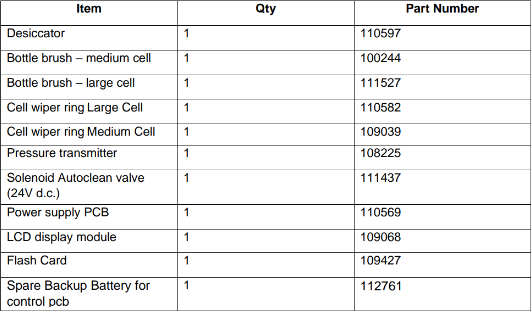Smart 50m Overview
For the measurement of oil in clean water.
Overview
The Smart 50m is a high precision oil-in-water analyser, designed for clean water applications where only oil may be present in fresh water. This analyser is typically used for fresh water feed monitoring and has been used in applications such as monitoring reverse osmosis plant inlets, brewery water supply monitoring and other applications where oil free, fresh water is a necessity.
Available in two ranges (0-10ppm and 0-200ppm), the accuracy is the Smart50m's specialty. The analyser can also be supplied in an Exd enclosure, allowing for use in potentially explosive atmospheres, complying to ATEX requirements.
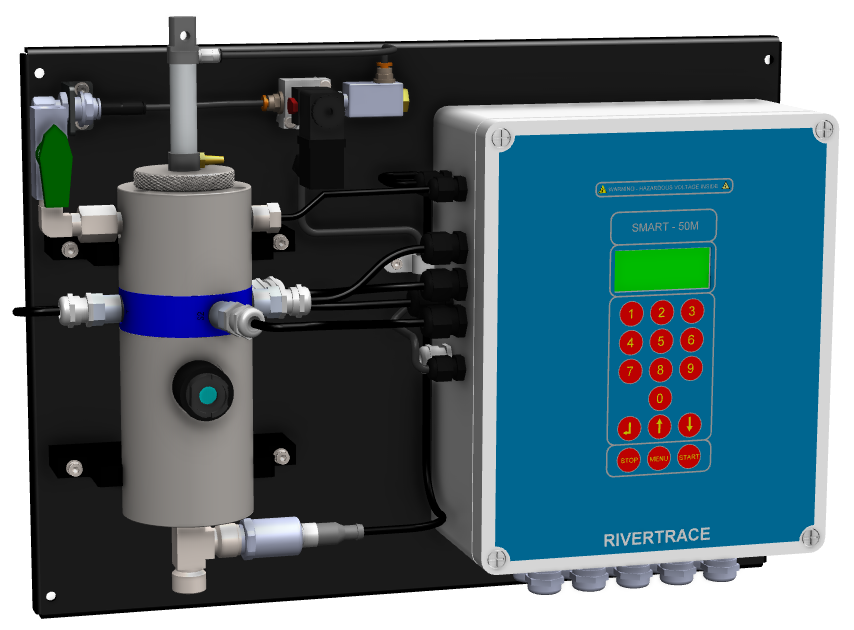
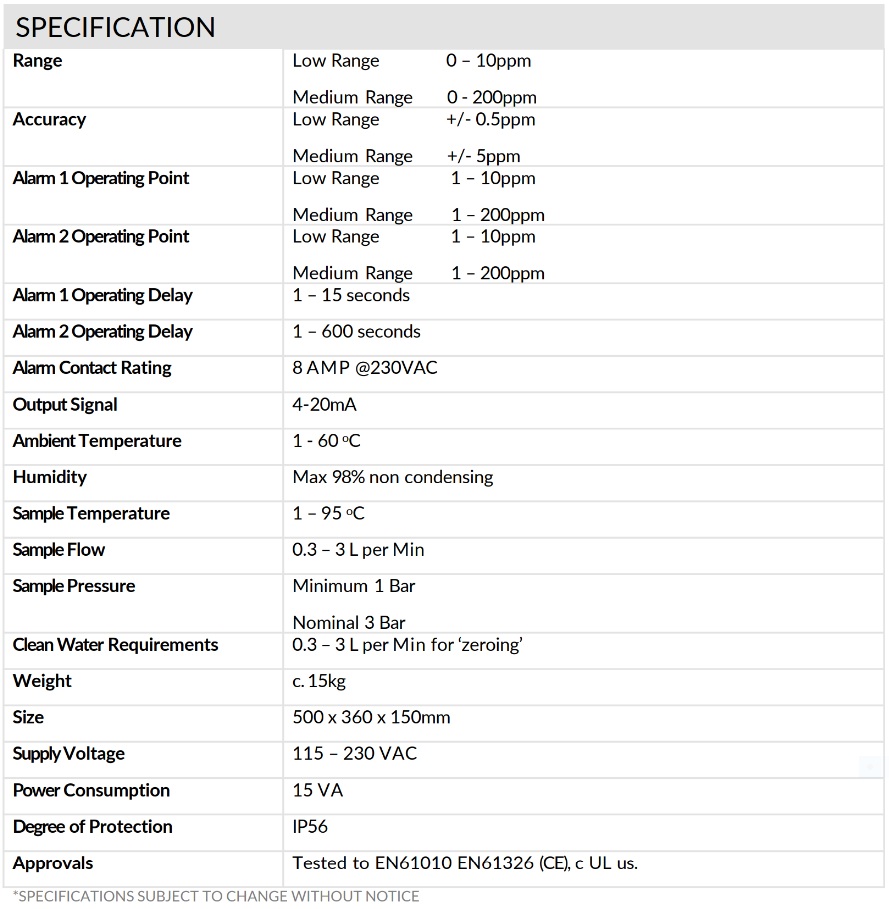
Layout
The Smart 50m is set out in three distinct parts; the Control module, the measuring cell and the Autoclean system. The components are mounted on a compact, powder coated aluminum backplate to give a neat and robust analyser that is easy to mount and access.
Control Module

The control module is mounted on the right side of the back plate and acts as the interface between the analyser and the outside world. All customer interactions can be made from the control module, using the keypad and information is clearly displayed at the backlit LCD Display.
The control module contains all electronics that allow the system to function (Other than pressure transducer and Autoclean solenoid). This is also where the processor and software, control relays and customer outputs are mounted.
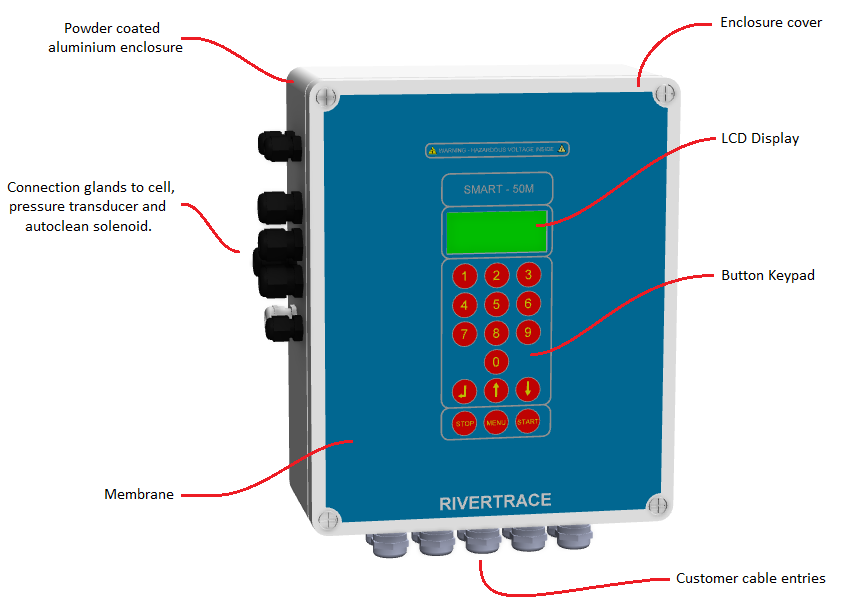
Within the IP65 enclosure, the user will find terminals for the following inputs and outputs:
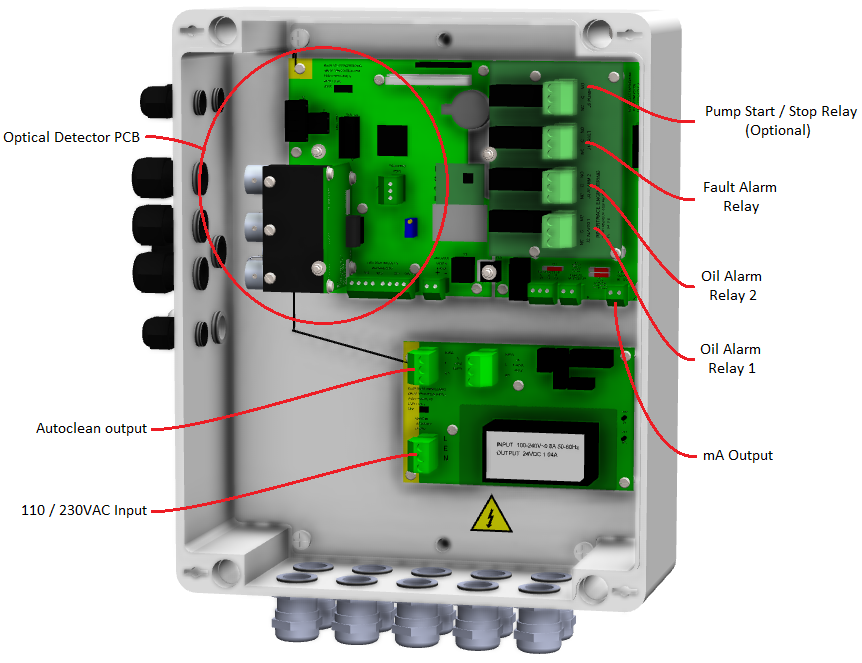
Optical Detector PCB - This is where optical light signals from fibre optic cables get converted into electrical signals to be processed. These sensitive components are calibrated and should never be tampered with, adjusted or disassembled or the calibration will be lost.
Autoclean Output - Is a terminal that supplies power to the Autoclean solenoid valve as and when required. The Autoclean period is user adjustable in the software so that intervals can be reduced to compensate for samples containing higher oil contents and a higher change of fouling.
110 / 230VAC Input - This is the only power supply that is required by the system. The monitor accepts 110 / 230VAC.
Pump start / stop relay - If the system is supplied with a pump due to site specific requirements, this relay will start and stop the pump as required.
Fault alarm relay - Relay that will change state if a fault or abnormal condition is detected.
Oil alarm 2 relay - This relay will change state when the oil content exceeds a user adjustable set-point. A user adjustable delay can also be set so that the oil content must exceed the trip point for a number of seconds before the relay changes state. This is useful for eliminating short PPM spikes tripping the alarm relay unnecessarily.
Oil alarm 1 relay - This relay will change state when the oil content exceeds a user adjustable set-point. A user adjustable delay can also be set so that the oil content must exceed the trip point for a number of seconds before the relay changes state. This is useful for eliminating short PPM spikes tripping the alarm relay unnecessarily.
mA Output - The mA output allows the user to monitor the calculated PPM remotely. 4mA equates to 0ppm and 20mA equates to full scale (10ppm or 200ppm depending on variant).
Measuring cell
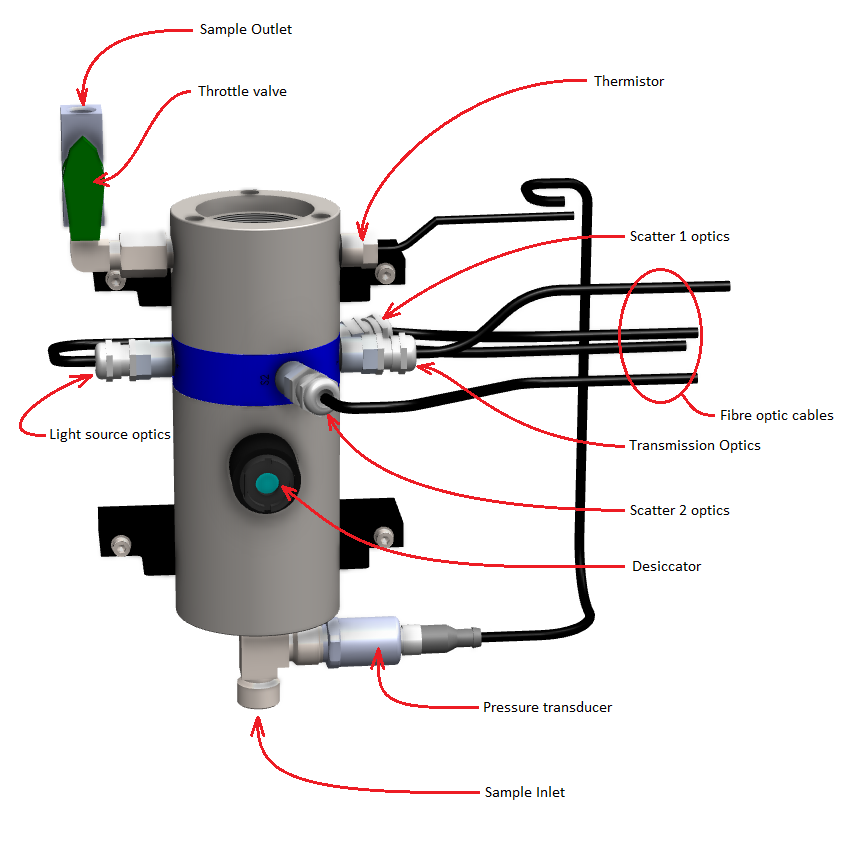
The measuring cell is a stainless steel cylinder mounted to the left of the backplate. All wetted parts are machined in 316 stainless steel as standard and are also available with traceability certificates. We also offer wetted parts machined in exotic materials on request, such as Monel, Super Duplex, Inconel, SS904 to name a few. NACE compliance is also on offer.
Sample Inlet - This 1/4" BSPP Female port is provided for customer pipework. The inlet is at the bottom of the assembly to allow gravity to aid the clearing of any air bubbles from the measuring cell.
Pressure transducer - Positioned close to the sample inlet and designed to monitor the sample pressure within the measuring cell. This allows the Smart50m to display the pressure value at the same time as generate an alarm should the pressure fall outside of the required tolerance.
Desiccator - The desiccator removes ambient moisture from the internal atmosphere of the cell, preventing condensation on the external walls of the glass tube allowing accurate measurement. This is the only serviceable part of the measuring cell and must be replaced when the blue window turns clear / white.
Light Source, Transmission, Scatter 1 and Scatter 2 optics - These are the optical components used to measure the oil content of the sample. No electronics are used within the measuring cell for this and the optical signals are passed back to the control module through fibre optics for analysis. These parts must never be disassembled or agitated or the calibration will be lost.
Thermistor - The thermistor in the measuring cell reports the sample temperature to the control module. If the sample temperature falls outside of its required tolerance, an alarm will be generated. The thermistor is also used for temperature compensation when calculating the oil content.
Throttle Valve - a throttle valve is positioned on the cell outlet and is designed to restrict the outlet, increasing the pressure within the measuring cell to an optimum pressure of 3 Bar. This is especially useful if air is present within the sample as a higher cell pressure compresses the air bubbles and reduces the impact on measurements.
Sample Outlet - This 1/4" BSPP Female port is provided for customer pipework. The outlet is at the top of the assembly to allow gravity to aid the clearing of any air bubbles from the measuring cell.
Autoclean System
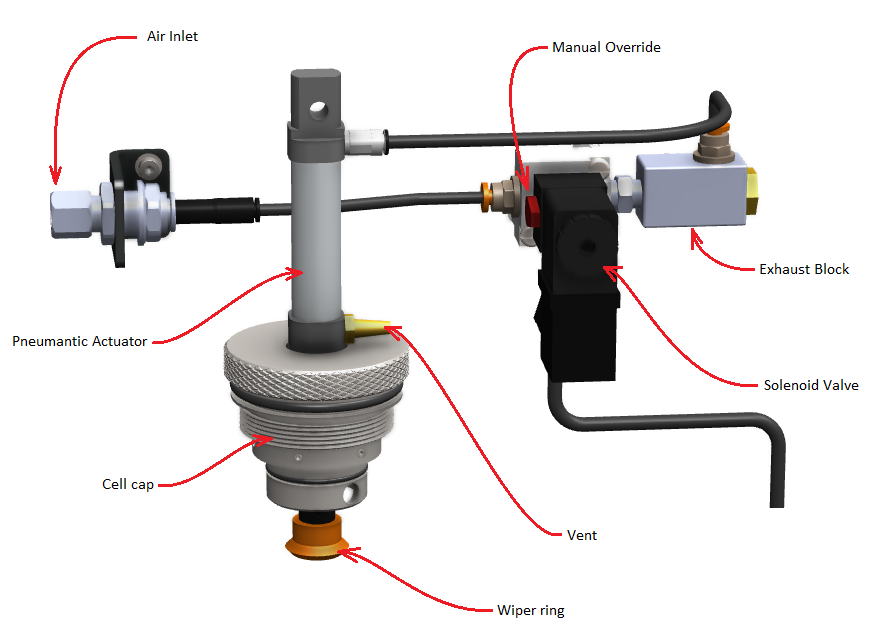
When passing potentially oily samples through sensitive optical equipment, fouling of the optics is inevitable unless a robust and reliable cleaning system is in place. For this reason, we install our tried and tested method of cleaning as standard to the Smart50m analyser.
Air Inlet - accepts 8mm tube to pneumatically charge the Autoclean system. An air pressure of 4 to 6 Bar is required and the consumption is extremely low, requiring as little as 6cm2/hr.
Pneumatic actuator - This is an anodised aluminium cylinder with stainless shaft that uses compressed air to push the wiper down and has an internal spring to withdraw the wiper back to the top position. There is also a vent beneath the piston to allow any pressure behind the piston to escape to atmosphere when the wiper is activated.
Cell cap - A stainless knurled cap that holds the Autoclean actuator into the top of the measuring cell. This should only ever be hand tight.
Wiper ring - This is a special rubber-like wiper that is designed to clean debris and oil from the inside of the glass tube. This is an extremely effective method of maintaining the cleanliness of the cell. The wiper ring must be replaced annually.
Solenoid valve - The Autoclean solenoid valve is controlled by the control module. When energised, the valve will allow a burst of air to be sent to the actuator which will push the piper down. On the side of the solenoid valve, there is a red manual override switch that can be operated by hand to wipe the measuring cell without the need for an electronic signal from the Smart 50m control module.
Exhaust block - When the pressure to the actuator is isolated after each wipe, the exhaust block will ensure that all residual pressure within the system is vented to atmosphere, allowing the wiper to return to the top position under power of the spring.
Routine Maintenance
Before each week of use
• Check that the analyser reads 0ppm with clean water flowing through the measuring cell. (If The PPM will not drop to 0ppm, this indicates that the cell tube will need cleaning).
• Check the colour of the desiccator window. If the window is blue, moisture levels are within operational limits. Replace Desiccator if the colour is either pink or white.
Yearly
• At yearly intervals (or where necessary) the wiper ring on the Autoclean assembly should be replaced. This can be ordered from Rivertrace directly under the following part numbers: 0-10ppm cell: 110582 / 0-200ppm cell: 109039
• Replace the desiccator.
Spare Parts
Customisation and bespoke systems
Due to the niche performance of the Smart50m, end users often need this system working in very varied environments meaning a one-size-fits-all approach is not practical. For this reason, the Smart50m is often integrated into bespoke "Systems" that handle site specific requirements. These additions include (But not limited to):
- Exd flame proof enclosure for hazardous areas, conforming to ATEX requirements in Zone 1 potentially explosive atmospheres.
- Stainless Steel mounting frame for a free-standing installation.
- SCU (Sample Conditioning Unit) for sample conditions that fall outside of our standard specification requirements.
- Sample Cooler for applications where the sample being received by the analyser is outside of our standard specification requirements.
- Vortex Enclosure Cooler for reducing the ambient temperature around the analyser in applications where extreme ambient temperatures fall outside of our standard specification requirements.
- Enclosure Heater for cold environments where freezing may cause damage.
- Stainless Steel sunshade to reduce the temperature around the analyser in exposed applications.
- Weatherproof enclosure to protect the analyser and associated equipment from severe weathers, flooding and deluge and of course acting as a mechanical protection against impact or tampering.
- Sample pressure regulators and PRVs for ensuring that the sample entering the system cannot cause damage should pressure spiking or high pressures occur.
Each bespoke system is supplied with a manual and technical drawings to support as standard and arrives to the customer as a finished product.

